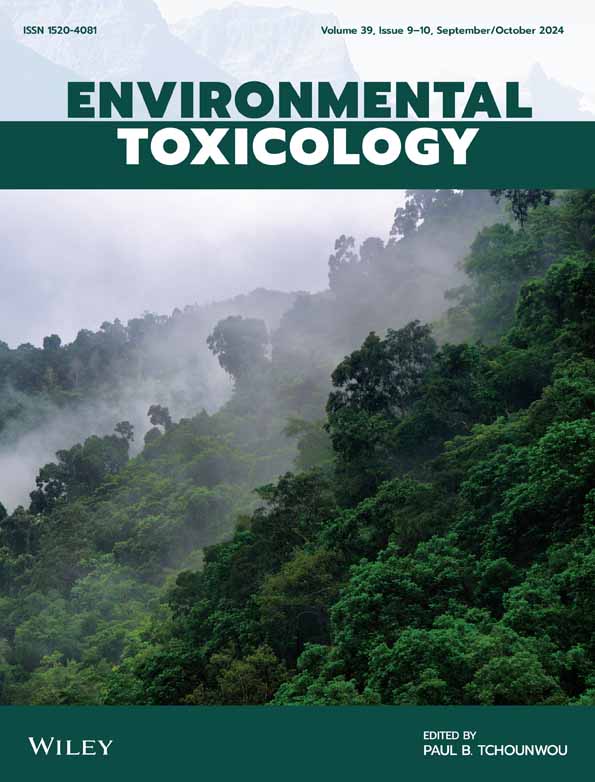镉诱导大鼠睾丸线粒体和MAMs失调:d -天冬氨酸的保护作用。
IF 3.2
3区 医学
Q2 ENVIRONMENTAL SCIENCES
引用次数: 0
摘要
镉(Cd)是一种重金属,会破坏精小管的结构,并在精子发育的多个阶段诱发细胞死亡。Cd也损害间质细胞(LCs),导致血清睾酮(T)水平降低。本研究主要研究了镉对大鼠睾丸线粒体室和线粒体相关内质网膜(MAMs)的影响。此外,d-天冬氨酸(D-Asp)通过与Cd同时或预防性给药来评估其减轻Cd诱导的甾体生成和精子发生效应的潜力。研究结果表明,Cd通过影响线粒体室和MAMs来发挥生殖毒性,这可以通过线粒体动力学失衡、线粒体自噬途径受损和线粒体生物发生下调来证明。Cd暴露也降低了脂质转移相关因子的表达,增加了内质网应激。此外,Ca2+转移相关蛋白水平的升高,表明Ca2+稳态受到干扰,可能与氧化应激和细胞凋亡的增强有关,这是已知的镉的影响。免疫荧光分析显示,镉诱导的线粒体和MAMs损伤在lc、精母细胞和精子细胞中很突出,证实了金属对类固醇形成和精子发生的不利影响。相反,D-Asp与Cd的共同给药或预防性给药可保持线粒体稳态和er -线粒体功能相互作用。总之,该研究为cd诱导生殖毒性的细胞机制提供了新的见解。重要的是,它强调了D-Asp通过增强线粒体和MAMs功能来预防或抵消Cd引起的睾丸损伤的功效。本文章由计算机程序翻译,如有差异,请以英文原文为准。
Cadmium-Induced Mitochondrial and MAMs Dysregulation in Rat Testis: The Protective Role of D-Aspartate.
Cadmium (Cd), a heavy metal, disrupts the structure of seminiferous tubules and induces cell death at multiple stages of sperm development. Cd also impairs Leydig cells (LCs), resulting in reduced serum testosterone (T) levels. This study primarily examined the impact of Cd on the mitochondrial compartment and mitochondrial-associated endoplasmic reticulum membranes (MAMs) in rat testis. Additionally, the potential of D-aspartate (D-Asp) to mitigate Cd-induced effects on steroidogenesis and spermatogenesis was assessed by administering D-Asp simultaneously or preventively with Cd. The findings demonstrated that Cd exerts reprotoxicity by affecting the mitochondrial compartment and MAMs, evidenced by an imbalance in mitochondrial dynamics, impaired mitophagy pathway, and downregulated mitochondrial biogenesis. Cd exposure also reduced lipid transfer-related factor expression and increased ER stress. Moreover, elevated levels of Ca2+ transfer-related proteins, indicative of perturbed Ca2+ homeostasis, may be associated with enhanced oxidative stress and apoptosis, which are known effects of Cd. Immunofluorescent analysis revealed that the Cd-induced mitochondrial and MAMs damage was prominent in LCs, spermatocytes, and spermatids, confirming the metal's adverse effects on steroidogenesis and spermatogenesis. Conversely, co-administration or preventive administration of D-Asp with Cd preserved mitochondrial homeostasis and functional ER-mitochondria interactions. In conclusion, the study offers novel insights into the cellular mechanisms underlying Cd-induced reprotoxicity. Importantly, it highlights the efficacy of D-Asp in preventing or counteracting testicular damage caused by Cd by enhancing mitochondrial and MAMs functionality.
求助全文
通过发布文献求助,成功后即可免费获取论文全文。
去求助
来源期刊

Environmental Toxicology
环境科学-毒理学
CiteScore
7.10
自引率
8.90%
发文量
261
审稿时长
4.5 months
期刊介绍:
The journal publishes in the areas of toxicity and toxicology of environmental pollutants in air, dust, sediment, soil and water, and natural toxins in the environment.Of particular interest are:
Toxic or biologically disruptive impacts of anthropogenic chemicals such as pharmaceuticals, industrial organics, agricultural chemicals, and by-products such as chlorinated compounds from water disinfection and waste incineration;
Natural toxins and their impacts;
Biotransformation and metabolism of toxigenic compounds, food chains for toxin accumulation or biodegradation;
Assays of toxicity, endocrine disruption, mutagenicity, carcinogenicity, ecosystem impact and health hazard;
Environmental and public health risk assessment, environmental guidelines, environmental policy for toxicants.
 求助内容:
求助内容: 应助结果提醒方式:
应助结果提醒方式:


